Bubble is visual programming - you drag elements around instead of writing code. Sounds great until you're 50 nested conditions deep trying to figure out why user auth just broke for no fucking reason. Here's what you're actually signing up for.
The Three Parts That Matter
Bubble apps have three main pieces:
- Frontend builder: Drag and drop elements onto pages. Works fine for basic layouts, becomes absolute hell for responsive design that doesn't look like garbage on mobile.
- Workflow system: Visual "if this then that" logic. Fine for simple stuff, turns into unmaintainable spaghetti when you need real business logic.
- Database: Built-in Postgres with a point-and-click query builder. Does basic CRUD, but forget about complex joins or anything resembling actual database optimization.
Everything runs on AWS infrastructure with auto-scaling. Good news: no server management headaches. Bad news: when performance goes to shit (and it will), you can't do jack about it. No CDN control, no database indexing, no caching strategy - you get whatever Bubble decides to give you and you'll fucking like it.
What "Visual Programming" Really Means
Instead of writing if (user.email_verified) { showDashboard() }, you click through dropdowns and conditional blocks like you're playing some twisted point-and-click adventure game. Database queries become drag-and-drop searches. API calls become workflow actions.
Sure, it's easier to start with, but debugging is like being an archaeologist in hell. You're hunting through nested workflows trying to find which conditional is fucked up. No stack traces, no real logs, just clicking through the visual editor praying you'll spot what's broken. The debugger shows you what's happening but figuring out why something breaks feels like solving a murder mystery where half the evidence is hidden.

Real Development Process
Here's what actually happens when you try to build something:
- Mock up some pages - The responsive engine works for basic layouts, but try building anything complex and you'll spend 3 hours fighting container layouts that should take 10 minutes in CSS
- Set up your data types - Database design is pretty straightforward until you need many-to-many relationships, then it gets weird fast
- Build workflows - This is where simple projects become nightmares. Basic page loads work fine, but complex business logic turns into a visual maze that makes you miss writing actual fucking code
- Debug in preview mode - Good luck with this one. The debugger shows you what's happening but figuring out why takes forever. Pro tip: open multiple browser tabs because the debugger crashes constantly
- Deploy and pray - Bubble handles deployment and hosting, which is actually nice, but you're locked into their platform forever. No code export, ever. You build it there, it stays there.
The Good and Bad Parts
What actually works:
- Basic CRUD apps
- User auth (when you set it up right)
- File uploads and payments
- Quick prototypes for simple shit
What makes you want to quit:
- Any real business logic
- Performance optimization (spoiler: you can't)
- Debugging visual spaghetti workflows
- Version control that makes Git look like rocket science
- Vendor lock-in forever
Performance is garbage. Load times are usually 3-10 seconds, sometimes worse. Those showcase examples they show? Yeah, those are the apps that actually work.

